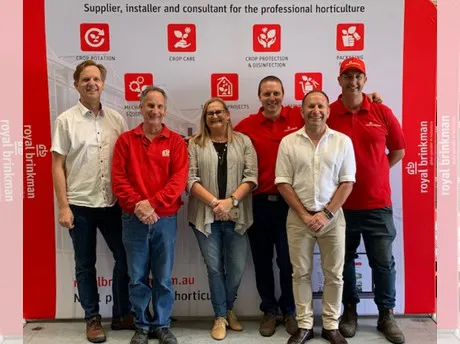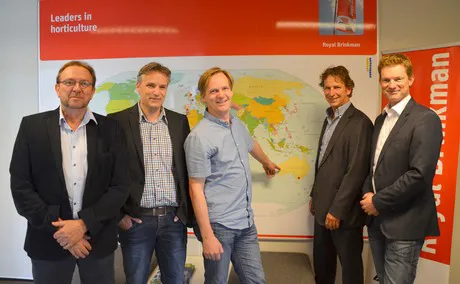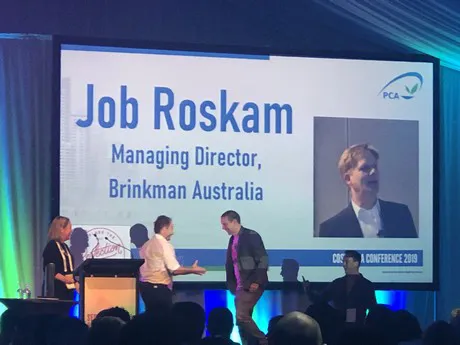Although he is saying goodbye to Royal Brinkman Australia, his heart remains in this country filled with horticultural possibilities. Back in 2000, Job Roskam moved to the Land Down Under and since then has seen the greenhouse horticultural industry develop at a rapid pace.
“Especially the vegetable cultivation has developed strongly in the last ten years,” he says. “The fact that supermarkets now need a qualitatively better and steadier supply of produce is an import reason for that. When I first got here back in 2000, the ornamental industry was ahead of the vegetable cultivation, mainly because many flower growers had a Dutch background. Nowadays, flower growers are struggling because there is a lot more import, then there was ten years ago. Although this might be changing now that the Australian government is implementing stricter import requirements.”
 Team Royal Brinkman Australia with Job on the left.
Team Royal Brinkman Australia with Job on the left.
Australia and New Zealand
In his role as managing director of Royal Brinkman Australia, Job was not only active on the Australian market but also in New Zealand. “Due to the location of both countries on the southern hemisphere, they can cultivate good products when it is winter for the northern hemisphere. New Zealand has a smaller national market, with a population of about 5 million. Because of that, it exports a part of the production to Australia and Asia. Australia, on the other hand, with a population of over 25 million, has a much larger national market and a lot less is exported. The downside, however, is that production is expensive in Australia while it can be produced a lot cheaper in other places in Asia.”
Despite that, the different climate zones in the country make it possible to cultivate a great variety of products. “In some cultivation areas, they grow in the open air or under a simple plastic greenhouse. “In the greenhouses made from glass you mainly find tomatoes, bell peppers, and cucumbers,” Job says. “Besides that, medicinal marihuana is very hot at the moment, and many investments are made in it. There are plenty of opportunities for suppliers to be found, and because they are now cultivating more in the ‘Dutch’ way, the demand for technology is also increasing. Which is something the Dutch are still very good at.”

Challenges: labor, energy, and water
There are also challenges, and for the growers, these challenges mainly have to do with labor, energy, and the availability of water. “The energy efficiency in Australia still has plenty of room for improvement, even if people started using energy-efficient equipment. They also don’t work with ‘Next Generation Growing’ all that much yet. The lack of water is due to the fact that a large part of Australia is currently having a drought, and things don’t seem to be getting better anytime soon.”
There is also a lack of laborers, especially in the areas outside of big cities where labor-intensive horticulture mainly takes place. Due to the fact that immigration has become more complicated, it is also harder to bring in people with specific knowledge. A lot of work is also being done by seasonal workers and backpackers, which is now being supported by the government. Regulations have recently changed, allowing backpackers to work for a longer period of time. Besides that, the government has been using the ‘Pacific Labor Scheme’ since last year, allowing more employees form countries in the Asian Pacific region, like Fiji, Kiribati and Papua New Guinea to start working in Australia and New Zealand. This in order to help with the current lack of laborers.”
Award
“I always gave my honest opinion when I was in Australia. I'd rather not sell a certain product if I don’t think it is right for the customer. After all, a long-lasting relationship with a client is much more important than a quick sale”, says Job, who recently was handed an award by the PCA for his ‘contribution to the Australian Protected Cropping industry’.

“As a former gerbera grower from the Dutch town of Vierpolders, I was raised with group excursions and sharing information. In Australia, I have continued this. The big companies get their information easily because seed companies and suppliers always approach them. It is, however, the group below them that is in need of information. That is why I think the work done by the PCA and the HFF is vital to the development of horticulture.”
Rest
With the award on the mantel, it is now time to relax. “I intended only to leave Royal Brinkman when a good replacement for me was found. Now that they have, I know that what we have built over the past years will continue running smoothly.” Job doesn’t yet know what he will be doing next. “I will first take some time to relax, and then I will see what comes my way. But I won’t be going back to the Netherlands. Not only don’t my wife and children want to move back, but Australia is a land with many opportunities for people with specific horticultural knowledge.”
For more information:
Job Roskam
job@roskam.com.au
www.roskam.com.au
